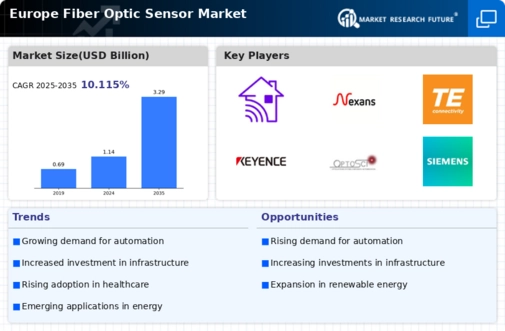Germany : Strong Demand and Innovation Drive Growth
Germany holds a dominant position in the European fiber optic sensor market, accounting for 35% of the total market share with a value of $350.0 million. Key growth drivers include robust industrial automation, increasing demand for high-speed data transmission, and government initiatives promoting digital infrastructure. Regulatory policies favoring renewable energy and smart city projects further enhance market potential, supported by significant investments in R&D and infrastructure development.
UK : Innovation and Investment Propel Market
The UK fiber optic sensor market is valued at $250.0 million, representing 25% of the European market. Growth is driven by increasing demand in telecommunications, healthcare, and smart grid applications. The UK government has implemented policies to enhance digital connectivity, including the rollout of 5G networks. This has led to a surge in fiber optic installations, particularly in urban areas, fostering a competitive landscape among local and international players.
France : Strong Industrial Base and Innovation
France's fiber optic sensor market is valued at $200.0 million, capturing 20% of the European market. Key growth drivers include advancements in telecommunications, automotive, and aerospace sectors. Government initiatives aimed at enhancing digital infrastructure and sustainability are pivotal. The French market is characterized by a strong focus on R&D, with significant investments in smart city projects and renewable energy applications.
Russia : Infrastructure Development Fuels Demand
Russia's fiber optic sensor market is valued at $150.0 million, accounting for 15% of the European market. Growth is driven by increasing investments in telecommunications and energy sectors, alongside government initiatives to modernize infrastructure. Demand for fiber optics is rising in urban areas, particularly in Moscow and St. Petersburg, where smart city projects are underway. The competitive landscape includes both local and international players, focusing on telecommunications and industrial applications.
Italy : Industrial Applications Drive Demand
Italy's fiber optic sensor market is valued at $120.0 million, representing 12% of the European market. Key growth drivers include the automotive and manufacturing sectors, which are increasingly adopting fiber optic technologies for automation and monitoring. Government policies promoting digital transformation and sustainability initiatives are also significant. Major cities like Milan and Turin are central to market activities, with a competitive landscape featuring both domestic and international firms.
Spain : Investment in Digital Infrastructure
Spain's fiber optic sensor market is valued at $100.0 million, capturing 10% of the European market. The growth is primarily driven by the telecommunications sector, with increasing investments in fiber optic networks to support 5G deployment. Government initiatives aimed at enhancing digital connectivity and smart city projects are pivotal. Key markets include Madrid and Barcelona, where competition is intensifying among local and global players in the fiber optic space.
Rest of Europe : Varied Growth Across Sub-regions
The Rest of Europe fiber optic sensor market is valued at $70.0 million, accounting for 7% of the total market. Growth varies significantly across countries, driven by local demand in telecommunications, healthcare, and industrial applications. Government initiatives to improve digital infrastructure and sustainability are common themes. The competitive landscape includes a mix of local and international players, each adapting to unique market conditions and regulatory environments.




















Leave a Comment